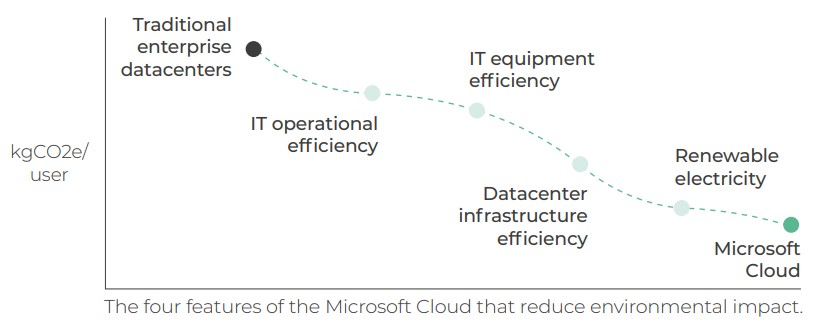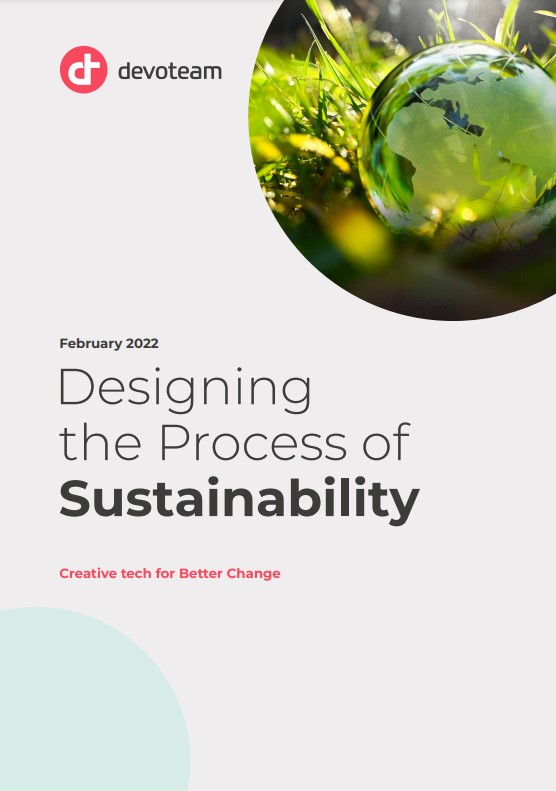For a company to continue to achieve business success in the future, two decisive factors come into play: sustainable business processes and an IT strategy geared to sustainability. With ever stricter regulations being laid down by law from the political side, a sustainable strategy has turned from a “nice-to-have” to a “must-have” for many companies. This trend will continue in the future, and government regulations will impose ever tighter framework conditions on companies, thus aligning with current international agreements. So those who deal with the topic of sustainability already today are actively contributing to their competitive advantage of tomorrow.
Decision-makers and managers meanwhile harbor prejudices about the negative impact a sustainable strategy might have on their budget planning. While such a corporate strategy is always good for the environment, it is more than often perceived as not compatible with corresponding business practices. As will be shown on the following pages, this is a far-reaching fallacy.
Quite the contrary is the case: A business strategy that focuses on sustainability and environmental protection has proven to be always in favour of the company’s finances. Even if not in the short term, then in any case in the long term.
This clearly shows that the topic of sustainability is not one that should be put on the back burner. The sooner companies incorporate appropriate business practices into their existing processes and use this strategy to plan the next steps toward digital transformation, the better equipped they will be for the future. There are four questions to be asked, of which the answers to are of essential importance when it comes to sustainability in the IT and business environment:
- Which hardware or PaaS solutions are in use when it comes to your data storage?
- How is your data managed and do you get the most of your data?
- Which software is used to work collaboratively and sustainably?
- Which overall cultural strategy do you have in place at your business to boost sustainable actions?

Reasons behind the importance of sustainability focus:
Expectations from different stakeholders were the most important: in particular, 53% of the respondents considered approval from customers to be a very important factor, and employee (49%) and leadership expectations (44%) were also seen as critical. More than 40% indicated that it gives them a competitive advantage.

When looking at those questions, it becomes clear that the task of implementing a sustainable IT infrastructure and thus laying the foundation for a competitive and future-proof undertaking is a time-intensive task that cannot be discussed in simply one meeting and be ready for a company-wide roll-out the next day. It is rather a process to be thoroughly introduced step by step into the organization on the basis of various parameters that will then be monitored through constant review.
Managers and decision-makers do not have to tackle this challenging path alone:
We at Devoteam can help develop a suitable strategy, and also draw on hyperscalers and vendors such as Microsoft. In efficient collaboration with our experts, companies can be made fit for a sustainable future in the long term and thus realize additional benefits as part of their digital transformation journey.
Let’s have a look into the various steps towards a sustainable corporate strategy. Those include which role KPIs and their determining tools play in this process and how individual corporate levels, such as data processing or the corporate structure and culture, can contribute to making a well-thoughtout sustainability strategy a corporate maxim.
Defining sustainability and cloud migration as the medium to harness companies’ sustainability challenges
As already indicated, for the future of many companies, it is crucial for them to start thinking about the best implementation of a sustainability strategy. Additional discussions should deal with how work processes and equipment can be used in a carbonefficient manner as well as how a corresponding corporate policy can be implemented throughout the entire enterprise. Reasons for that are numerous:
Environmental protection and nature conservation are the most important driving forces behind an overall sustainable strategy. It is not in their intent to start the reduction of one’s greenhouse gas emissions only at a later point. Now is the time to act, as urgent appeals from environmental organizations, policy makers and social movements like Fridays for Future show. To avert further damage to our planet, it is therefore crucial to gear our lives and economies towards sustainability as quickly as possible.
On the other hand, there are also intrinsic reasons to be named for companies to act as quickly as possible. By switching to sustainable software and hardware, important resources such as energy can be saved compared to conventional business processes. If a company resorts to cloud solution providers like Microsoft Azure for example, corresponding expensive data centers become unnecessary. Moreover, additional capacities can be added flexibly within the cloud according to the current needs – a circumstance that would only be associated with difficulty and corresponding costs when using one’s own physical data centers.

When gearing the business environment and its IT infrastructure to sustainability, your company will be ahead of time, as you will be already adapted to the expected future guidelines and regulations before they are in place. Today, companies in various fields like the chemical or metalworking industry already have to purchase expensive emission certificates to offset their own carbon footprint. It is to be expected that these legal framework conditions will also become increasingly relevant for other industries and sectors especially against the background of the EU’s and other local government’s ambitious plans. In consequence, stricter legal frameworks would then ensure that non-sustainable business practices will be gradually banned in the future.
From a strategic perspective, the focus on a smaller carbon footprint is currently coming at a highly favorable time anyway: while many companies are still looking for the right approach to their own digital transformation journey, service providers as well as vendors such as Microsoft now offer mature technologies. These are characterized by their future scalability and the reducing impact on their own greenhouse gas emissions balance sheet, while designing their own business processes more efficiently all along.
Microsoft offers a holistic portfolio of services to enable digitization and help companies on their digital transformational journey: from smart cloud applications, collaboration platforms and SharePoint solutions to specialized applications. Together with you, we at Devoteam can draw on the resources of hyperscalers such as Microsoft to design a customized strategy that simultaneously combines the necessary aspects of sustainability and efficiency.
Expert Summary
Here is what decision-makers and those responsible should always bear in mind when asking themselves whether their sustainability strategy makes sense for their company:
- Environmental protection and sustainability are pressing issues that, at best, were already addressed several years ago.
- By adopting sustainable business processes such as cloud migration, companies can save valuable resources and at the same time gain far-reaching flexibility
- The earlier the transformational work is done, and a sustainable business environment is being implemented, the faster future government requirements and legislation can be met (cf. Climate Pact EU 2035).
The digital transformation process affects all business areas that many companies have still ahead of them. Those who plan the company’s future in a sustainable way right from the outset can execute the implementation largely without any problems and become fit for the rest of the 21st century.
Evaluating the company’s environmental impact with key indicators (Microsoft Carbon Calculator)
While it is clear for various reasons that companies must act now to create a sustainable business environment and sustainable management has to become a natural part of long-term corporate planning, the first steps are still often nebulous for many. As with all essential business decisions and strategic concepts, it makes perfect sense to first determine one’s own status quo and, based on this, to hold initial discussions with external experts and known business partners. Fortunately, companies that are beginning to address the issue of sustainability can already benefit from the achievements of other pioneers. Microsoft, for example, has worked hard in the past to achieve previously set environmental standards and sustainability goals. The result? Microsoft’s cloud services are carbon neutral and therefore also a perfect solution for digital transformation.
The key point is: No one expects decision-makers to have the one solution ready that represents the perfect course for the next decade. On the contrary: These plans need to be worked out in detail and implemented in such a way that they form a natural fit to the individual company processes. An initial inventory, using tools provided by Microsoft, can be a good starting point. It should be noted that many large companies are aware of their own social responsibility and know about the effects of their own
cloud services on the global carbon dioxide balance. Practice what you preach: This phrase is also valid in this case. Not acting on one’s promises has never fit in with any problem so far and most certainly will not solve the problem of climate protection. Microsoft has taken on the responsibility and is now working on operating its own data centers with electricity from renewable energy sources by 2025.
In addition, Microsoft also offers their partners and interested stakeholders tools to review their own sustainability strategy. That is especially with regard to the cloud and the migration of traditional data centers and other solutions. The Microsoft Emission Impact Dashboard is a simple and low-threshold application for managers and decision-makers. It clearly shows what impact the selected solutions can have and how much carbon dioxide companies can potentially save through a cloud migration. The tool, which is based on Power BI, clearly illustrates how individual components of a company’s digital strategy influence the carbon footprint generated by the company and how Azure cloud services for example, can efficiently help with the sustainability strategy. Local conditions, such as the local electricity mix, the utilization and consumption of the Microsoft cloud data center, as well as additional values for applications and services are also considered in the calculation of the respective data.
Based on an assessment of the existing IT infrastructure, Devoteam experts, in consultation with you, will discuss planned projects for digital transformation, opportunities for digitization and optimization of processes. Additionally, topics such as future collaboration tools and existing hardware and software
will be addressed, analyzing thereby all relevant aspects that offer improvement potential for a better sustainability at the company level. Together with decision-makers, managers and the company’s IT specialists, a dedicated roadmap will be created that marks the achievement of the previously set goals. Various business levels take on a central role in that case since those fields offer the most optimization potential, as experience has shown.
